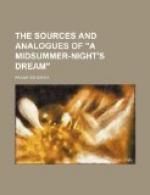The sources from which Shakespeare drew the plots of his three dozen of plays are for the most part easily recognisable; and although in each case the material was altered to suit his requirements—nihil tetigit quod non ornavit—there is as a rule very little doubt as to the derivation. We can say with certainty that these nine plays were made out of stories from Boccaccio, Masuccio, Bandello, Ser Giovanni, Straparola, Cinthio or Belleforest; that those six were based on older plays, and another half-dozen drawn from Holinshed; that Chaucer, Gower, Lydgate, Sidney, Greene, and Lodge provided other plots; and so forth, until we are left with The Tempest, founded in part on an actual contemporary event, Love’s Labour’s Lost, apparently his only original plot—if indeed it deserve the name—and finally our present subject A Midsummer-Nights Dream.
The problem—given the play—is to discover what parts of it Shakespeare conveyed from elsewhere, and to investigate those sources as far as is compatible with the limits of this book. For this purpose, it is most convenient to adopt the above-mentioned division into three component plots or tales; and because these are rather loosely woven together, the characters in the play may be simultaneously divided thus:—
1. Theseus. The main (sentimental)
plot of the four
Hippolyta. lovers
at the court of Theseus.
Egeus.
Philostrate.
Lysander.
Demetrius.
Helena.
Hermia.
2. Bottom. The grotesque plot, with
the interlude
Quince. of Pyramus
and Thisbe.
Snug.
Flute.
Snout.
Starveling.
3. Oberon. The fairy plot.
Titania.
Puck.
Fairies.
It may be observed that for these three plots Shakespeare draws respectively on literature, observation, and oral tradition; for we shall see, I think, that while there can be little doubt that he had been reading Chaucer, North’s Plutarch and Golding’s Ovid, not to mention other works, probably including some which are now lost, it is also impossible to avoid the conclusion that much if not all of his fairy-lore is derived from no literary source at all, but from the popular beliefs which must have been current in oral tradition in his youth.




